Classic shortbread gets a peppermint (bark) twist with a drizzle of white and dark chocolate and a flurry of crushed candy cane bits for a festive treat Santa is sure to love!
As far as holiday cookies go, shortbread is a classic for a good reason: it’s ridiculously easy to prepare and delicious to boot. But shortbread combined with peppermint bark (another holiday classic)? That’s one marvelous holiday mashup.

I actually started this recipe last year, but didn’t have time to make it perfect and posted before Christmas. While my concept was solid (combining buttery shortbread cookies with peppermint bark is a stellar combination), the final execution left much to be desired.
My first attempt was downright messy (to say the least).
If you’ve made shortbread before you know that cutting the cookies while warm is absolutely necessary if you want clean cuts, as opposed to a crumbly mess if you try and cut into cooled cookies.
But I wanted to top the cookies with peppermint bark, which meant adding two layers of tempered chocolate to the tops of cooled cookies (cooled so the chocolate would actually set); additionally, the chocolate could not be added to already cut cookies otherwise it’d just flow into the cracks and glue the cut cookies together.
What I ended up with was sure delicious, but uglier than a Christmas sweater, with the shortbread crumbling to bits underneath the layer of snappy chocolate on top when I went to cut it. And I know, taste is the most important thing, obviously, but it wasn’t just about appearances: the crumbly mess-of-a-cookie was equally hard to handle and just not practical, no matter how good it tasted.
At this point it was two days before Christmas and really too late to post any new holiday cookie recipes anyway, let alone re-test this recipe to get it just right, so I jotted down a few notes and stuck a bookmark in my recipe notebook with the intention to revisit this recipe next year.

Fast forward to this December… and we’ve finally brought the execution up to bar with the concept.
In short(bread, lol), it’s all about the drizzle!
Drizzling the chocolate on top of the cookies, rather than spreading on a solid layer, allowed me to cut the cookies while they were still warm, then add the chocolate and candy cane once they’d cooled, solving the execution problem entirely.
The result is what may just be your new favorite Christmas cookie: tender, buttery shortbread, drizzles of both white and dark chocolate, and a flurry of crushed candy cane for a perfect peppermint twist.
Not to mention shortbread keeps beautifully, no refrigeration required, making this cookie a perfect option for cookie swaps and make-ahead party fare.


I ultimately decided to bake this in a round tart pan, thinking that the triangular-shaped wedges gave off a Christmas tree-like vibe.
You’ll want to use a round tart pan or springform pan (anything with a removable bottom, basically, which will make it easy to lift the baked cookies out of the pan to cut while they are still warm).
You can also bake this in an 8-by-8-inch square pan and cut into squares or rectangles. If you plan to ship or share the cookies, squares may be more practical as they’re a bit sturdier than the pointy triangles, whose tips have a tendency to crumble.


Classic shortbread contains only 3 ingredients: butter, sugar, and flour (plus salt if not using salted butter).
This recipe is a true shortbread, with a tender and buttery texture that, yes, gets a little crumbly, but is also delicious and enjoyable to eat without being too sweet.
I’ve made some faux-shortbreads before that contain egg, resulting in a less crumbly, more sugar cookie-like texture. If you want a sturdier cookie or want something more chewy vs tender/crumbly, you can also use the faux-shortbread recipe, and just add the chocolate and candy cane topping as described here.

Shaping & Scoring
When pressing the crumbly dough into your pan, I found it easiest to lay a second round of parchment on top of the dough, then rub a flat-bottomed glass on top. This helps create a perfectly smooth, level surface that you could never achieve with your hands.
You’ll then want to score the dough, which makes for easier and more accurate cutting after baking.
Instead of eyeballing it, I folded the same round of parchment I used to press the dough in half, then used that half as a template for my first score, using a pastry cutter to get nice straight marks (I used this same tool to cut the shortbread after baking).
Then fold the half circle into thirds as evenly as you can; use that triangle to help you make your next score marks. Then eyeball the last set, dividing the 6 wedges into 12 total.
You could also opt to cut it into 16 smaller pieces, however the skinnier triangles will be even more fragile.
Finishing Touches
Once the cookies have been cut and cooled, then comes the fun part: the drizzle!
I recommend trying to temper your chocolate, which will set up nice and snappy and won’t smudge if the cookies are touched or stacked. You can also use chocolate bark or candy coating, which don’t taste as good (in my opinion), but contain additives to give them a snappy finish without tempering.
I find the easiest method for tempering is the seed method, which you can achieve by warming about 3/4 of the chocolate over very low heat (a double boiler would be best here, or an electric chocolate melting pot like I have).
When it is fully melted, remove from heat and add remaining chocolate, stirring gently until it’s melted and cooled but still smooth. This ‘seed’ chocolate will help bring the temperature of the chocolate down to where crystals will begin to form; the seeds also help achieve the proper crystallization structure that results in snappy, tempered chocolate.
You’ll then want to transfer the liquid chocolate to a piping bag fitted with a small round tip, or a plastic bag (which you can then snip off a tiny corner and use to drizzle on top of the cookies). Since you will melt the white chocolate first, you can use the same pan to melt the dark (but not the other way around).
Baking Tip: to keep the white chocolate warm while you melt the dark, place the piping bag inside a small glass, then set inside a loaf pan or another pan filled with hot water. This keeps just enough warmth around the piping bag to keep the chocolate liquid, without overheating it or exposing it to water (which can cause the chocolate to seize).
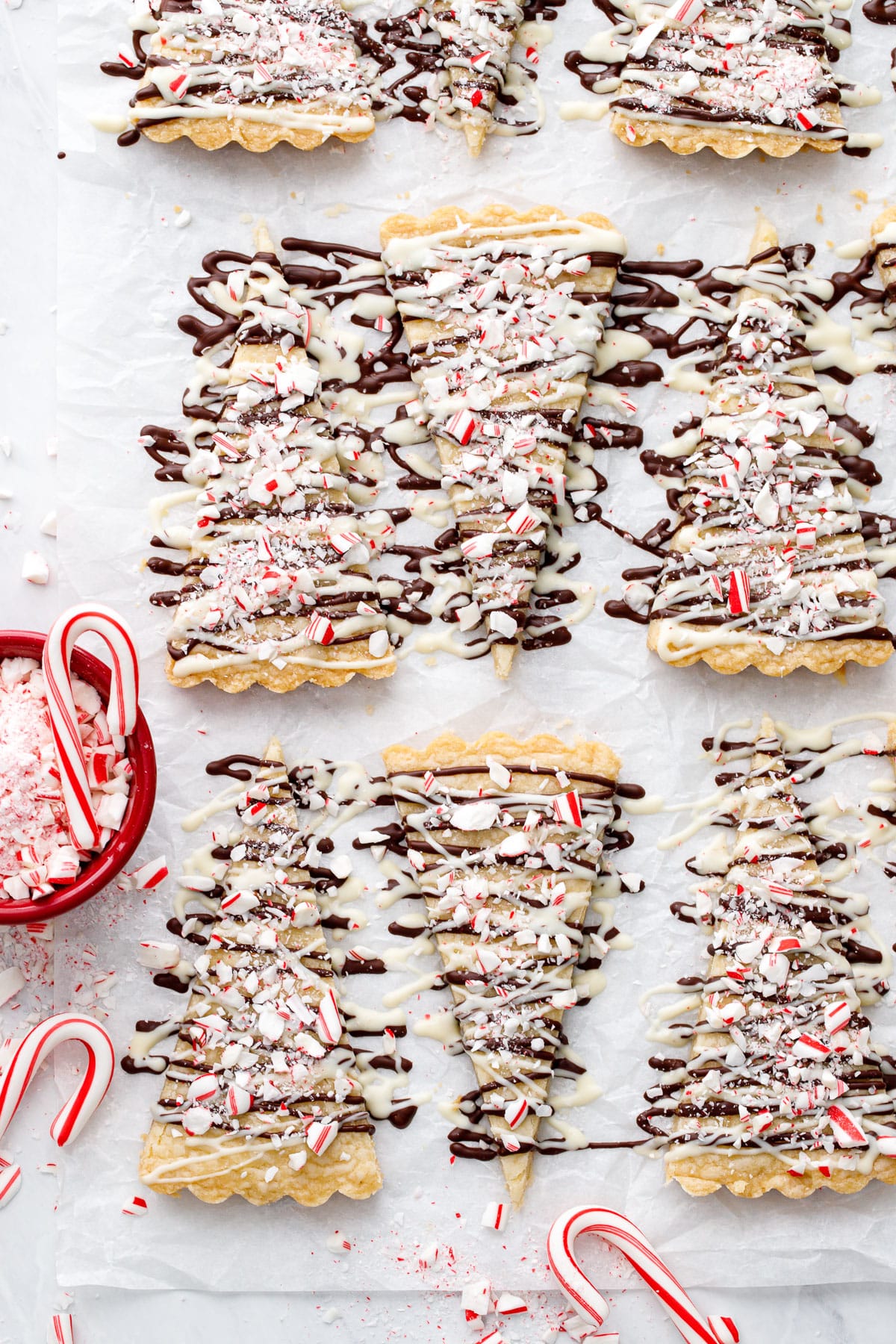
The crushed candy cane topping gives a perfect amount of mint flavor to the buttery cookies (though I did add 1/2 teaspoon of peppermint extract to the cookie base as well).
The topping is simply crushed up candy canes; I opted for mini ones since they are easier to crush and have a better ratio of red to white for appearances.
To easily crush candy canes, keep them in the plastic wrappers and gently tap them with the bottom of a spoon until crushed into small bits. You don’t want the pieces too large or they won’t stick as well; the smaller, even fine powdery bits give you a better distribution of peppermint flavor.
Once the candy cane is sufficiently crushed, snip off the end of the wrapper and dump into a bowl.
For this recipe you’ll need about 10 mini candy canes or 2 full size ones.

Swaps & Substitutions
I used high-quality European-style butter here, which has a higher fat content than American-style butter and a more robust buttery flavor. Since the primary flavor of shortbread is, in fact, butter, the quality of your butter matters. If you use American-style butter here I’d recommend reducing the flour by a tablespoon or two, as the dough may be too dry and crumbly otherwise.
While I used unsalted butter, salted butter works just as well (reduce the added salt to 1/4 teaspoon if so).
I added a bit of peppermint extract to the dough to amp up the peppermint flavor, but you can omit this if you like (or use vanilla and/or almond extract instead).
In place of the white/dark chocolate, you can also use chocolate/almond bark or candy coating. While these don’t taste as good (in my opinion), they do have the benefit of not requiring tempering for a hard and snappy finish. Melt according to the package instructions.
If you like the idea of chocolate-drizzled Christmas tree-shaped shortbread but can’t stand the flavor of candy canes, feel free to leave out the peppermint extract and replace the crushed candy cane with sprinkles instead.
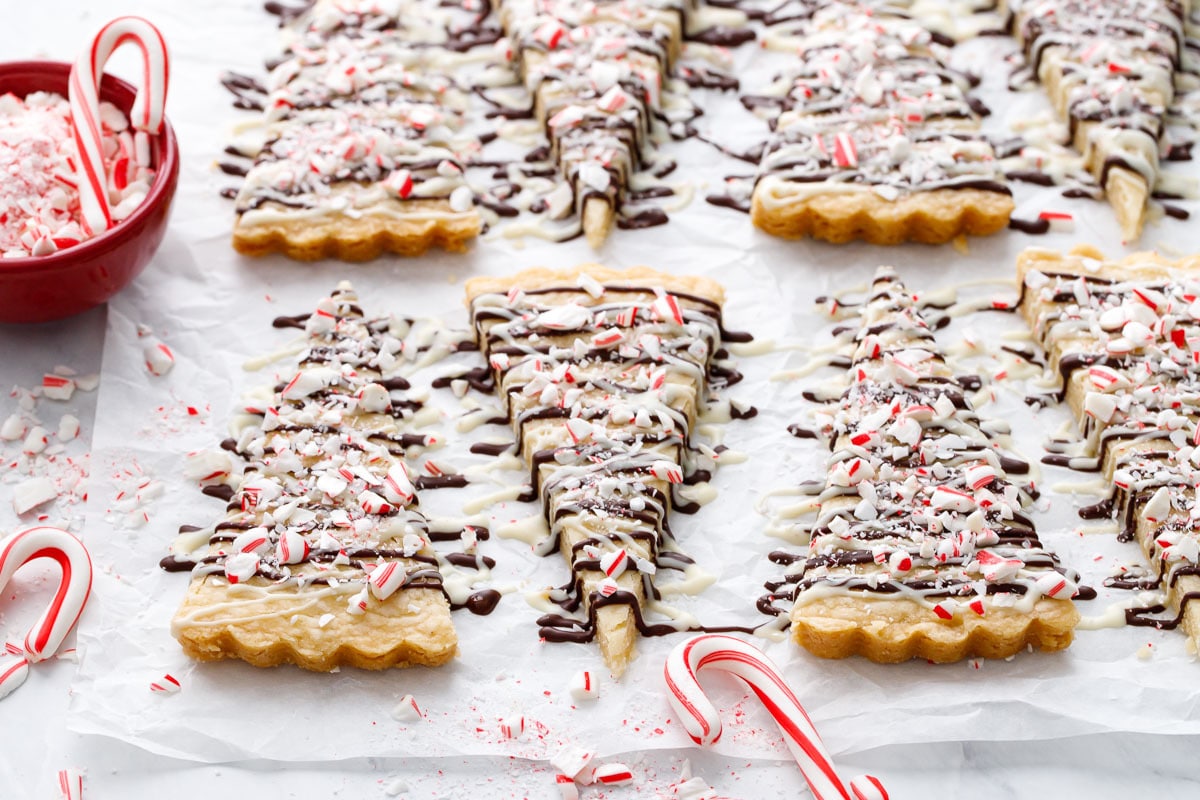
Peppermint Bark Shortbread
Ingredients
- ¾ cup / 170 g butter, at cool room temperature (I recommend a good quality European-style butter)
- ½ cup / 50 g powdered sugar, sifted
- ½ teaspoon fine sea salt, reduce to ¼ teaspoon if using salted butter
- ½ teaspoon peppermint extract, optional
- 1½ cups / 188 g all-purpose flour
- 1 ¾ oz / 50 g white chocolate, finely chopped (you can also use candy coating and/or almond bark if you don't want to deal with tempering)
- 1 ¾ oz / 50 g dark chocolate, finely chopped (ditto above)
- crushed candy canes, for topping
Instructions
- Lightly butter a 9-inch round tart pan or springform pan with a removable bottom. Line bottom with parchment paper (this will make the cookies easier to slide off later).
- In a mixing bowl or the bowl of a stand mixer fitted with the paddle attachment, beat butter and powdered sugar 2 to 3 minutes until light and fluffy. Add salt and peppermint extract, if using.
- With the mixer running on low speed, slowly add flour, mixing until flour is incorporated. The dough will be fairly crumbly, but should stick together when pinched between your fingers.
- Dump crumbly dough into prepared pan, and press into an even thickness. I find it helpful to place a round of parchment on top of the dough, then use a flat-bottomed glass to press and smooth it into a flat, even layer without sticking. (You'll re-use this piece of parchment to help score the cookies as well).
- Fold the parchment round in half, then place it on top of the dough. Use a knife or a pastry scraper to score a line in the dough (don't cut all the way through, you're just scoring it at this point).
- Fold the half circle of parchment into thirds, then use that as a template to score the dough into 6ths. Finally, Score each wedge in half once more, making 12 pieces in total.
- Refrigerate for 20 to 30 minutes to allow the dough to set.
- Meanwhile, preheat oven to 300 degrees F.
- Bake chilled shortbread for 45 to 50 minutes, or until top and edges are light golden brown. Remove from oven and set on a wire rack to cool 1 minute, then carefully lift the cookie out, removing the sides of the tart pan (be careful as the pan is still hot). Cut wedges of shortbread following the score lines you made before baking. Cutting the shortbread while it is still hot will allow you to get clean cuts without it crumbling too much.
- Let the cut shortbread (still arranged in a round) cool completely on the wire rack, at least 30 minutes.
- Meanwhile, gently melt the white chocolate. I recommend trying to temper the chocolate using the seed method, which you can achieve by warming about 3/4 of the chocolate over very low heat (a double boiler would be best here, or an electric chocolate melting pot like I have). When it is fully melted, remove from heat and add remaining chocolate, stirring gently until it's melted and cooled but still smooth.
- Transfer white chocolate to a piping bag fitted with a small round tip, or a plastic bag (which you'll snip off a tiny corner and use to drizzle on top of the cookies).
- Repeat with the dark chocolate, melting about 3/4 of it gently over low heat, then adding the remaining chocolate to bring the temperature down and encourage proper crystal structure. Transfer to a second piping bag or plastic bag.
- Carefully transfer shortbread wedges to a clean piece of parchment paper (or some other surface to catch the overflow drizzle). Use the piping bag in a back and forth motion to pipe lines of dark chocolate across the cookies. Repeat with white chocolate. Immediately sprinkle with crushed candy cane. (I found piping about 4 cookies at a time gave me time to add the candy cane before the chocolate sets. If you used almond bark/candy coating it may set up more quickly, and you'll want to be sure to add the candy cane on top before it does so. A second set of hands would be helpful here!)
- Cookies will keep at room temperature in an airtight container (lined with parchment paper between layers as needed), for up to a week.
Notes
- Tip: to keep the white chocolate warm while you melt the dark, I placed the piping bag inside a small glass, which I placed inside a loaf pan filled with hot water. This keeps just enough warmth around the piping bag to keep the chocolate liquid, without overheating it or exposing it to water (which can cause the chocolate to seize).


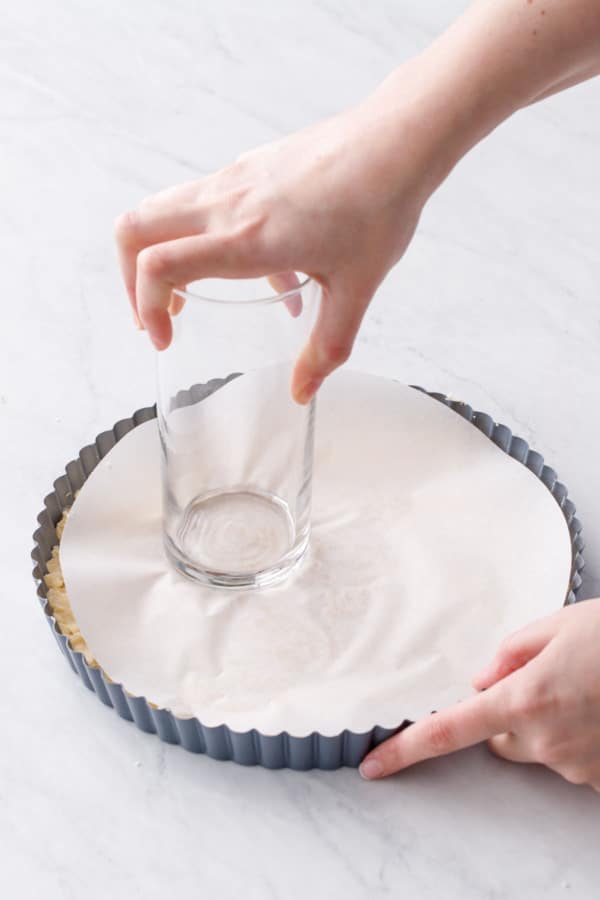




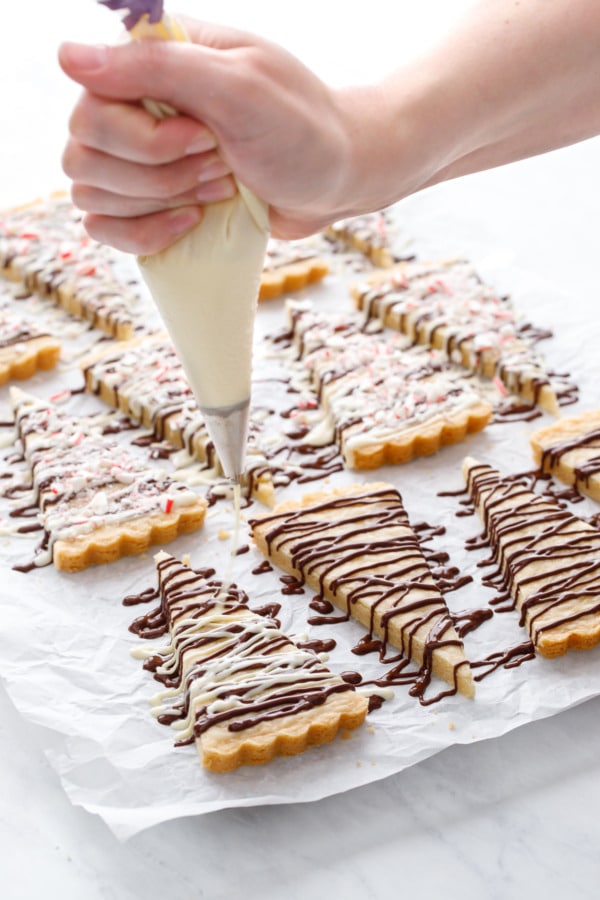
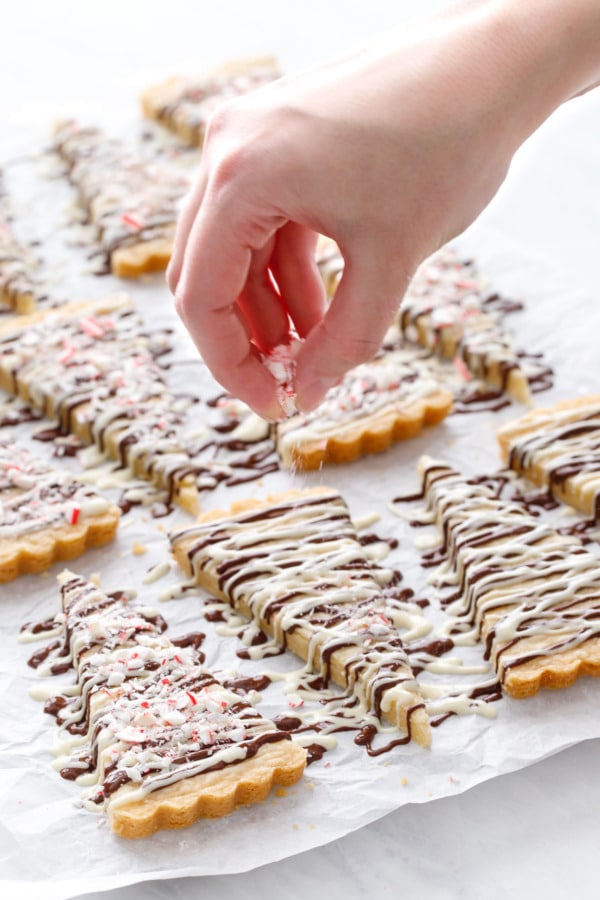
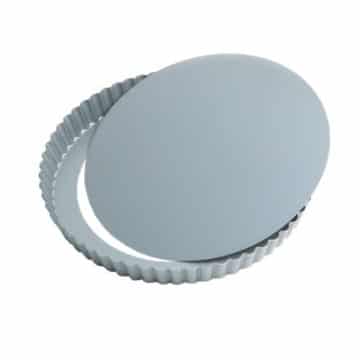
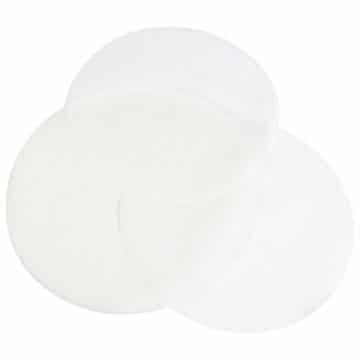










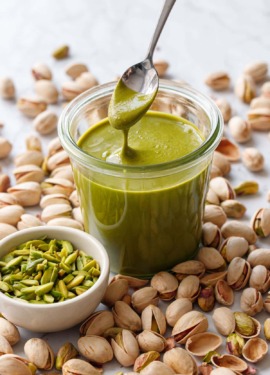
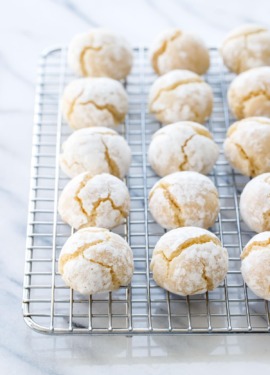



Made these for Christmas and used the softer shortbread as recommended for ease of transport. They looked and tasted great!
This recipe for Peppermint Bark Shortbread is a festive holiday treat! The shortbread is buttery and crumbly and the chocolate and peppermint topping adds a nice crunch!!
– Jack from skilletguy.com
I love your pictures for this post! They’re very simple, but so pretty.
YUM. Thank you for the delicious recipe. It was easy to make and your directions were spot on. Only thing I didn’t have was a pastry bag.
Can’t wait to share them.
Recipe is a definite keeper and will make for other occasions.
fun shortbread recipe, I much prefer these flavors to my traditional shortbread recipe, dark chocolate, yay, thank you!